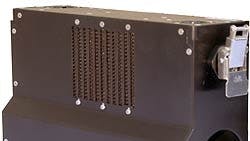While many technologies such as GPS and radar were first proven in military applications and then commercialized, fuel cell technology from Jadoo Power that has been proven in commercial niche markets has attracted the attention of the U.S. military, specifically the U.S. Army’s Special Operations Command (SOCOM). The effort to improve the operational endurance of portable military systems now powered by batteries represents another “niche market” that can be addressed by Jadoo’s fuel cell technology.
Fuel cells enable the power and energy-storage capacities of a portable power system to be defined independently. A complete fuel cell system that incorporates hydrogen storage technologies such as metal hydride can have an overall energy density greater than conventional batteries. According to Lee Arikara, V.P. of Business Development at Jadoo, these systems can not only enhance mission capabilities, but can also ease logistical burdens imposed by conventional primary batteries.
Arikara stated that while Jadoo is targetting commercial and military applications requiring fuel cells to provide from 20 W to 5 kW, its current military power systems operate in the 45-W to 100-W range. In these systems, standard modules for each basic component can be combined and configured with other module types to form a complete power system. There is a separate module for the fuel cell, a battery or supercapacitor, the power electronics, the control system and the storage of hydrogen fuel (fuel module).
The control system performs power management, data logging and fuel gauge functionality for the fuel module. The accuracy of the fuel gauge is ±5%, while there is no accurate fuel gauge for the BA5590, a high performance battery used by the U.S. military, according to Arikara. The other modules can be paralleled to increase energy or power capacity of the system.
The two options for the fuel module are metal hydride and chemical hydride technology. Metal hydride is field rechargeable, while chemical hydride is for one-time use (but factory-recyclable) and provides from 480 kWhr/kg to 600 kWhr/kg of energy density. This is nearly four times greater than the conventional BA5590 Lithium-Sulfur-Dioxide batteries used by the U.S. military, Arikara stated.
Because the chemical hydride option usage model is a direct substitute for batteries, aspects of its operation are being researched for various mission scenarios. The chemical hydride cells can be shipped as solids with water added in the field. The impact of water quality on the operation of these cells and even the logistical advantages of operation from human waste are being examined.
The next power level for Jadoo’s military fuel cell systems to be addressed will be the 100-W to 300-W range. At present, the BA5590 battery also services this power range. This could lead to applications such as main or auxiliary power for unmanned aerial vehicles (UAVs).
Any modular approach is in keeping with other military programs, such as the F-35 Joint Strike Fighter and the Joint Tactical Radio System. This modular approach is also conducive to strategic partnerships, according to Jack Peterson, V.P. of Marketing & Sales at Jadoo.
Recently, the U.S. Secretary of Energy appointed Jadoo to the newly formed Hydrogen and Fuel Cell Technical Advisory Committee (HTAC). Peterson stated that part of Jadoo’s business strategy for advancing its fuel cell technology is to focus on military projects with potential commercial applications. This compliments Jadoo’s strategy of developing mission-specific military fuel cell systems from standard modularized components.
The emergence of commercial and military fuel cell technology presents new opportunities for power designers. Rather than displacing their knowledge of mature technology, fuel cell systems will challenge power designers to incorporate it in hybrid systems that also incorporate fuel cells to achieve performance targets. Power Management will be critical for these systems.
Arikara stated that Jadoo will focus on two fundamental aspects of power management in future systems. One aspect is power conditioning to meet the requirements for the load, and the other is maintaining modular scalability for substantially increased power levels.
Fuel cell systems will see increased usage in mobile and portable military applications. In some parts of the world, electrical infrastructures are being destroyed during military operations. In addition to systems for theater operations, even larger modularized fuel cell systems that restore power to demolished electrical infrastructures may one day be standard equipment for military peacekeepers.
